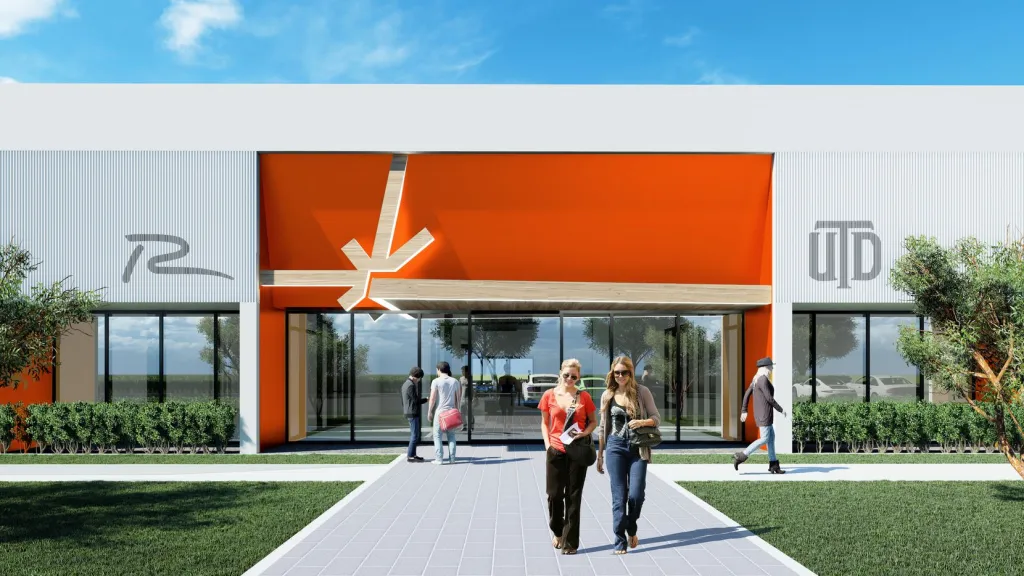Richardson and UTD Partner for New Innovation District Hub

The University of Texas at Dallas is teaming up with the city of Richardson on what they hope will be a transformational project — a new anchor for what Richardson is calling its Innovation Quarter.
The district includes about 1,200 acres east of U.S. Highway 75 in one of the city’s oldest business areas.
The city plans to redevelop a building it owns at 1302 E. Collins Boulevard to house its Office of Strategic Initiatives and five newly created UTD research centers.
“The city will establish a presence in the Innovation Quarter and joining us in the Collins building will be UT Dallas,” said Richardson deputy city manager Don Magner. “They will create a new center that is housed there.”
Magner said the city will use the new facility as a base for its efforts to revitalize the area.
“On the UTD side it will largely be co-working and lab space — a little more research-driven,” he said.
UTD is planning research centers for Applied Artificial Intelligence and Machine Learning, the Center for Imaging and Surgical Innovation, the Multi-Scale Integrated Interactive Intelligent Sensing Center and the Center for Smart and Connected Mobility.
UTD will also put its new Center for Applied AI at the Richardson Innovation Quarter. It’s described as “a multi-disciplinary center that will showcase emergent applied AI research to engage companies, win extramural grants, strengthen international partnerships and provide a global network for affiliated students to excel as UT Dallas alumni.”
UTD will occupy about 10,000 square feet of the 27,500-square-foot building. Richardson has owned the property, which was built in 1979, since 2001.
The redeveloped building is set to open in early 2022.
Richardson has been working on a development plan for the Innovation District since 2017. Property owners, businesses and city officials teamed up to work on ideas.
“They felt the area was underperforming and could be much more than it was,” Magner said. “We are trying to maximize the development potential and identify some key projects the city could engage in and be a catalyst for the area.”
Starting in the mid-20th century, the area Richardson is calling its Innovation Quarter housed some of the region’s best know tech and telecom firms. The district now is home to Argo Data, Digital Realty, Ericsson, Honeywell, id Software, Raytheon, Siemens, Verizon and many smaller tech-oriented firms.
“One of the goals was to develop a space to stimulate collaboration and attract new jobs,” Magner said. “One of the main partnerships that we wanted to strengthen was with UT Dallas.
“We began exploring ways we could have UT Dallas plant their flag in the district.”
UTD president Richard C. Benson said in a statement: “The city of Richardson and UT Dallas have long had a deeply intertwined, mutually beneficial relationship focused on tech-oriented research, business innovation and training of bright minds, With this announcement, we are proud to bring teams from across the university’s eight schools to be deeply, directly engaged in the Richardson IQ for years to come.
“Working hand-in-hand with the city, surrounding business community and other institutional partners, we look forward to collaboratively solving some of our nation’s greatest business, medical, transportation and sustainability challenges.”
Click here to view the press release.
Source | Dallas News
ABOUT THE UT DALLAS COMPUTER SCIENCE DEPARTMENT
The UT Dallas Computer Science program is one of the largest Computer Science departments in the United States with over 4,000 bachelors-degree students, more than 1,010 master’s students, 140 Ph.D. students, 52 tenure-track faculty members, and 42 full-time senior lecturers, as of Fall 2021. With the University of Texas at Dallas’ unique history of starting as a graduate institution first, the CS Department is built on a legacy of valuing innovative research and providing advanced training for software engineers and computer scientists.




